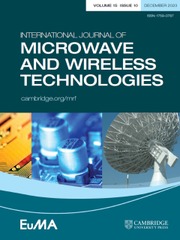Microstrip antennas on 3D-printed magneto-dielectric substrates: fabrication and efficiency study
Published online by Cambridge University Press: 23 February 2023
Abstract
Magneto-dielectric antennas (MDAs) provide small sizes, enhanced bandwidths, and frequency/polarization agility. We describe the fabrication and efficiency characterization at 0.4–0.8 GHz of five microstrip MDAs, whose gradually thicker substrates were 3D-printed using an off-the-shelf polylactic acid (PLA) filament doped with ferromagnetic particles. It was experimentally discovered that efficiency increases monotonically from 12% (−9.2 dB) to 37% (−4.3 dB) as substrate thickness goes from 1.6 to 4.3 mm; the rate is faster than expected for microstrip antennas. Numerical analysis indicated that the apparent magnetic loss tangent of the MD substrate experiences a threefold decrease as the 3D printer deposits more layers of iron-doped PLA. The MDAs exhibit radiation quality factors that are 3.7–7.2 times better than the dielectric counterparts. Moreover, a simple optimization of ground plane size could increase efficiency to 55% (−2.6 dB). The reduction in magnetic loss is attributed to a reduction in eddy current loss due to the separation of agglomerate iron particles. Therefore, despite the inherently lossy material used, the potential of 3D-printed MD substrates in providing acceptable antenna efficiencies is demonstrated together with unprecedented design freedom and fabrication flexibility.
Keywords
- Type
- Antenna Design, Modelling and Measurements
- Information
- International Journal of Microwave and Wireless Technologies , Volume 15 , Special Issue 8: EuCAP 2022 Special Issue , October 2023 , pp. 1412 - 1423
- Copyright
- © The Author(s), 2023. Published by Cambridge University Press in association with the European Microwave Association
References
- 1
- Cited by



